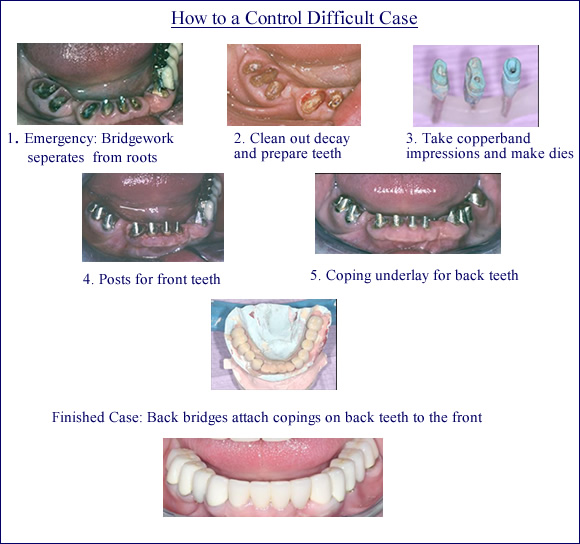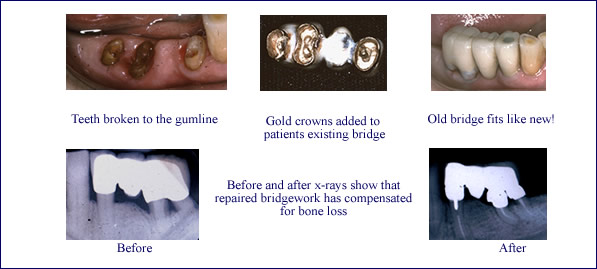SAVE HOPELESS TEETH
Teeth Flush with the gumline can be saved without posts or build-ups.
We save teeth first – Implants are a last resort
Saving Teeth is Often Better Than Placing Implants
Many teeth that some practitioners condemn to extraction are far from hopeless. If there is sound root structure and sufficient bone around the root, the tooth can be saved. The determining factor is not what is above the gum, but below the gum. Many practitioners don’t know how to restore these teeth with crown and bridgework, but they do know how to restore implants. As a result, patients are commonly offered implants as their only restorative option.
Techniques for Crown and Bridgework that have been in existence for over seventy years can save teeth that are condemned to extraction in many offices. Implants are wonderful restorations, but they are not the solution to every restorative problem, and there are situations where implants cannot even be placed. While implants have a high percentage of success, no one can foresee which patient will reject an implant, and they can be lost even after many years in the mouth. The patient is often far better off when teeth can be salvaged with treatment that is far less invasive and time-consuming than implants. Implants can almost always be placed as a last resort.
Fact: Teeth fractured at the gum line are often salvageable with conservative surgical techniques. As long as there is adequate tooth structure below the gum, the teeth can easily be salvaged. Restorations can be made on these teeth that will not fall out, even without cement.
Fact: Copper Band impressions ensure that crowns will adequately grip the root surface below the gum so that there will be adequate retention. The copper bands are also used to make temporaries that fit like permanent restorations so they do not fall out in between visits. Few Dentists know how to use copper bands and dental schools do not teach dental students how to use them.
Control of Difficult Cases
This patient had bridgework fall out on an emergency. The teeth were decayed to the gum line. Copper bands were added to her bridge at the emergency visit so she could walk out with teeth. Individual impressions were taken of the back teeth in order to cover them with copings to prevent further decay. The front bridge was made without porcelain on the two canines. Two Back bridges were then fabricated to connect the front bridge with the back metal copings. All the teeth are essentially connected together in order to distribute the forces evenly among the weak teeth. “Roundhouses” or full arch dental restorations connected in one piece can never fit properly because it is impossible to parallel all the teeth on both sides of the arch and because the materials are not designed for use in big sections. Fabricating dentistry in two layers of metal is technically difficult and demands meticulous attention to detail. However, overlay bridgework offers the patients the advantage of far less invasive solutions in the event that something goes wrong.
Repair of Bridgework
Decay under long-standing bridgework—if caught early—can often repaired with fillings. At a certain point it may be wise to remake the bridgework. However, sometimes remaking the bridgework is not a good investment, but repair of bridgework can add additional years of service to the existing bridge. The patient below has worn bridgework for 20 years. One day, the teeth supporting the bridge snapped off at the gum line. The patient is not a candidate for implants. Without repair of this bridge, the patient would have to wear a removable bridge. He would essentially be a “dental cripple”, because a one-sided removable bridge cannot function properly. After root canal treatment was completed, individual impressions of the teeth were taken. Copings were fabricated from these impressions and added with acrylic to the existing bridge. The result is an old bridge that fits like a brand new one! The X-Rays show that the “new” bridge relates much more closely to the bone than the “old” bridge. The forces are therefore applied much more closely to the supporting structures and this stabilizes the remaining teeth.



